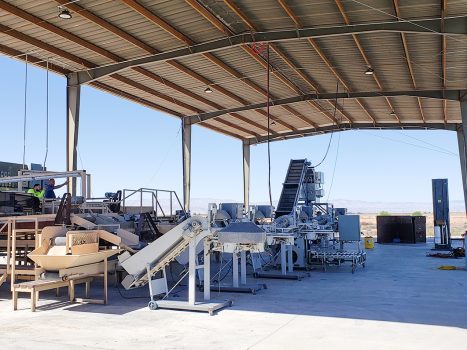Onion stats show numbers of farms, total acreage
By Kathleen Thomas Gaspar
Showing some interesting trends in domestic ag, stats in the recently released USDA 2017 Census of Agriculture indicate that at just over 2 million, the total number of farms and ranches in the United States has declined 3.2 percent since the 2012 Census.
The number of male producers fell by 1.7 percent in the five years between Census counts while, due to changes in demographic questions about decision-makers on the farms, the total number of producers increased, and women producers specifically increased by 27 percent.
We spoke with Teresa White, public affairs specialist at the U.S. Department of Agriculture in its National Agricultural Statistics Service, and she provided us with figures pertaining to the onion industry in this enormous census report.
The 2017 tally for dry onion farms in the U.S. was 8,717, with 163,982 acres. Of those farms, 8,321 harvested for fresh market from 116,416 acres, and 569 farms harvested for process from 47,563 acres. In 2012 the total number of onion-specific farms was 6,192, with 149,960 acres.
In ’17 there were 7,054 farms with 0.1 to 0.9 acres for a total of 416 acres. Farms from 1 to 4.9 acres numbered 824 with a total of 1,343 acres; there were 140 farms with 5 to 14.9 acres for a total of 1,103 acres; 15-24.9 acre farms numbered 47 for a total of 870 acres; 25-49.9 acre farms numbered 84 for a total of 3,000 acres; 50-99.9 acre farms numbered 138 for a total of 9,548 acres; 100-249.9 acre farms numbered 252 for a total of 38,190 acres; 250-499.9 acre farms numbered 111 for a total of 36,856 acres, and onion farms with 500 acres or more numbered 67 for a total of 71,664 acres.
Two specific links Teresa sent provide state-by-state information showing the increase or decline in number of farms and harvested acreage. Acreage numbers see-sawed among some of the major production areas. In California there were 38,128 acres and 561 farms in 2012, and in 2017 there were 764 farms and 42,555 total fresh and process acres in onions. Colorado, on the other hand, went from 254 farms and 6,432 acres in 2012 to 154 farms and 3,694 total acres in 2017, according to the Census.
Georgia had 63 farms and 11,341 acres in 2012, compared to 126 farms and 11,051 total acres in 2017. Idaho reported 214 farms and 9,761 acres in 2012 and 165 farms and 12,452 total acres in 2017.
The 2012 numbers for New Mexico were 141 farms and 5,457 acres, and in 2017 there were 147 farms and 6,915 total acres. Oregon reported 526farms and 20,457 onion acres in 2012 and 403 farms with 26,965 total acres in 2017. Texas had 249 farms and 14,090 acres in 2012; in 2017 Texas reported 376 farms and 11,708 total acres. And Washington reported 734 farms and 22,010 acres in 2012, compared to 356 farms and 29,535 total onion acres in 2017.
A comprehensive release sent out April 11 by the USDA noted 2017 Ag Census results span “some 6.4 million new points of information about America’s farms and ranches and those who operate them, including new data about on-farm decision making, down to the county level.” The info came from the source, that is the farmers and ranchers themselves, who told the government “both farm numbers and land in farms have ongoing small percentage declines since the last Census in 2012.” But, the release continued, “At the same time, there continue to be more of the largest and smallest operations and fewer middle-sized farms.” And, “The average age of all farmers and ranchers continues to rise.”
Agriculture Secretary Sonny Perdue said the results of the Ag Census can be used “to tell the tremendous story of U.S. agriculture and how it is changing. As a data-driven organization, we are eager to dig in to this wealth of information to advance our goals of supporting farmers and ranchers, facilitating rural prosperity, and strengthening stewardship of private lands efficiently, effectively, and with integrity.”
Interestingly, new data shows trends right down to the county level, and according to NASS Administrator Hubert Hamer, the current picture shows “first-time data on topics such as military status and on-farm decision making.”
Access to the information is easy by going to www.nass.usda.gov/AgCensus. Key highlights in the results are bulleted below, and OnionBusiness has put some bold type for emphasis:
- There are 2.04 million farms and ranches (down 3.2 percent from 2012) with an average size of 441 acres (up 1.6 percent) on 900 million acres (down 1.6 percent).
- The 273,000 smallest (1-9 acres) farms make up 0.1 percent of all farmland while the 85,127 largest (2,000 or more acres) farms make up 58 percent of farmland.
- Just 105,453 farms produced 75 percent of all sales in 2017, down from 119,908 in 2012.
- Of the 2.04 million farms and ranches, the 76,865 making $1 million or more in 2017 represent just over 2/3 of the $389 billion in total value of production while the 1.56 million operations making under $50,000 represent just 2.9 percent.
- Farm expenses are $326 billion with feed, livestock purchased, hired labor, fertilizer and cash rents topping the list of farm expenses in 2017.
- Average farm income is $43,053. A total of 43.6 percent of farms had positive net cash farm income in 2017.
- Ninety-six percent of farms and ranches are family owned.
- Farms with Internet access rose from 69.6 percent in 2012 to 75.4 percent in 2017.
- A total of 133,176 farms and ranches use renewable energy producing systems, more than double the 57,299 in 2012.
- In 2017, 130,056 farms sold directly to consumers, with sales of $2.8 billion.
- Sales to retail outlets, institutions and food hubs by 28,958 operations are valued at $9 billion.
Also key is the change in demographic questions posed, specifically about on-farm decision making, and the latest Census shows “the number of producers is up by nearly seven percent to 3.4 million, because more farms reported multiple producers. Most of these newly identified producers are female. While the number of male producers fell 1.7 percent to 2.17 million from 2012 to 2017, the number of female producers increased by nearly 27 percent to 1.23 million. This change underscores the effectiveness of the questionnaire changes.”
Other demographic highlights include:
- The average age of all producers is 57.5, up 1.2 years from 2012.
- The number of producers who have served in the military is 370,619, or 11 percent of all. They are older than the average at 67.9.
- There are 321,261 young producers age 35 or less on 240,141 farms. Farms with young producers making decisions tend to be larger than average in both acres and sales.
- More than any other age group, young producers make decisions regarding livestock, though the difference is slight.
- One in four producers is a beginning farmer with 10 or fewer years of experience and an average age of 46.3. Farms with new or beginning producers making decisions tend to be smaller than average in both acres and value of production.
- Thirty-six percent of all producers are female and 56 percent of all farms have at least one female decision maker. Farms with female producers making decisions tend to be smaller than average in both acres and value of production.
- Female producers are most heavily engaged in the day-to-day decisions along with record keeping and financial management.


